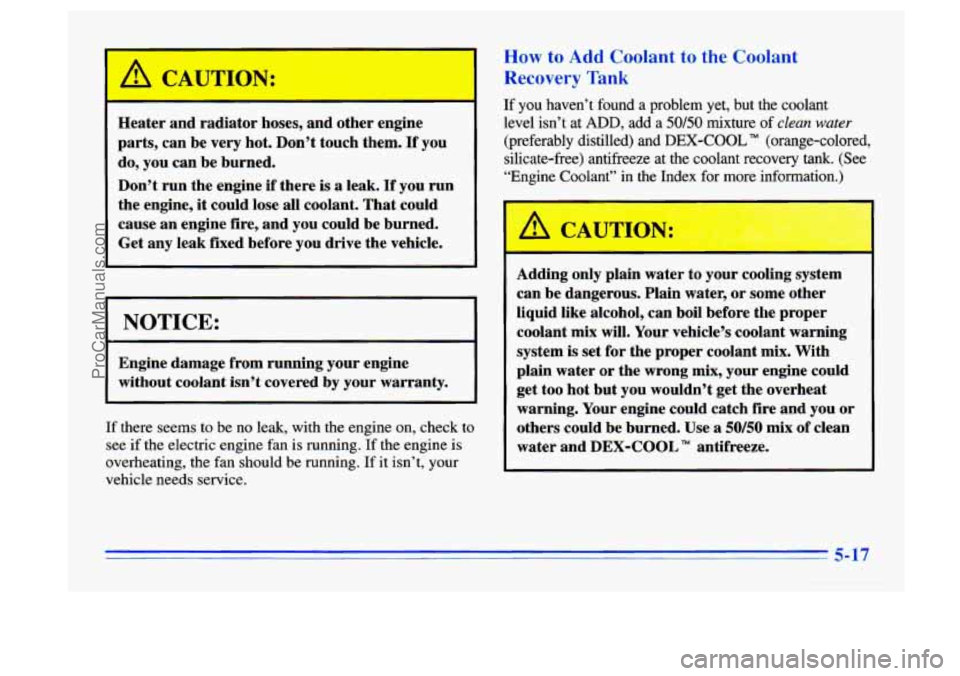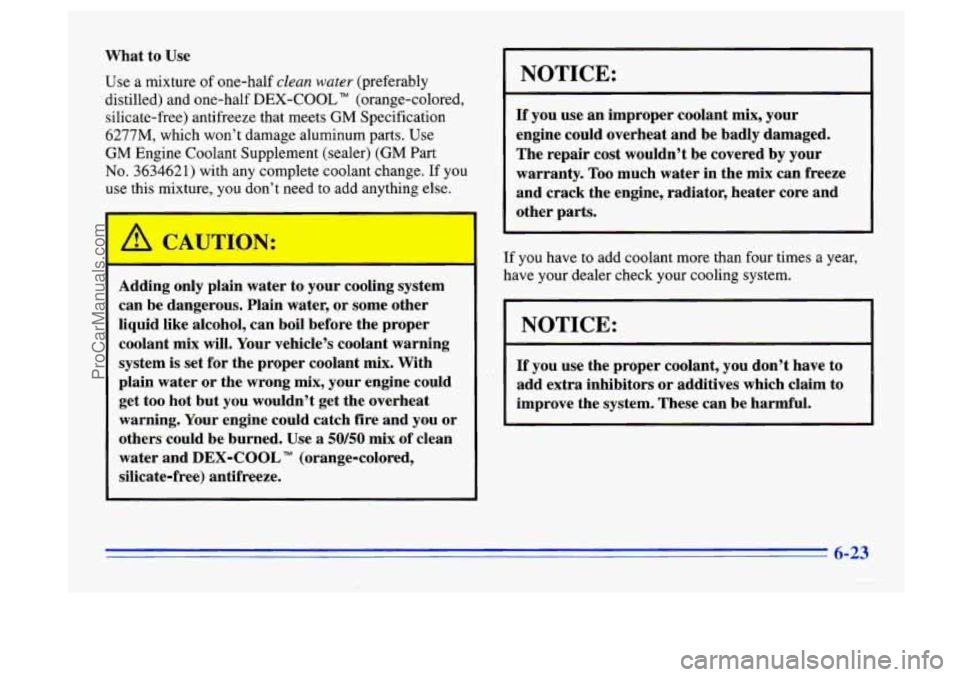Page 181 of 340
When you decide it’s safe to lift the hood, here’s what
you’ll see:
2.2L L4 Cooling System
A. Coolant Recovery Tank
B. Radiator Pressure Cap
C. Electric Engine Fan
3.1L V6 Cooling System
A. Coolant Recovery Tank
B. Radiator Pressure Cap
C. Electric Engine Fan
5-15
ProCarManuals.com
Page 182 of 340
(ACA u TT” I:
An electric fan under the hood can start up even
when the engine is not running and can injure
you. Keep hands, clothing and tools away from
any underhood electric fan.
If the coolant inside the coolant recovery tank is boiling,
don’t
do anything else until it cools down.
2.2L L4 Engine
3.1L V6 Engine
The coolant level should be at the FULL HOT mark. If
it isn’t, you may have a leak in the radiator hoses, heater
hoses, radiator, water pump or somewhere else in the
cooling system.
5-16
ProCarManuals.com
Page 183 of 340

A C U-ION:
Heater and radiator hoses, and other engine
parts, can be very hot. Don’t touch them.
If you
do, you can be burned.
Don’t run the engine if there
is a leak. If you run
the engine,
it could lose all coolant. That could
cause an engine fire, and you could be burned.
Get any leak fixed before you drive the vehicle.
NOTICE:
Engine damage from running your engine
without coolant isn’t covered by your warranty.
If there seems to be no leak, with the engine on, check to
see if the electric engine fan is running. If the engine is
overheating, the fan should
be running. If it isn’t, your
vehicle needs service.
How to Add Coolant to the Coolant
Recovery Tank
If you haven’t found a problem yet, but the coolant
level isn’t at ADD, add a
50/50 mixture of clean water
(preferably distilled) and DEX-COOL (orange-colored,
silicate-free) antifreeze at
the coolant recovery tank. (See
“Engine Coolant” in the Index for more information.)
Adding only plain water to your cooling system
can be dangerous. Plain
water, or some other
liquid like alcohol, can boil before the proper
coolant mix will. Your vehicle’s coolant warning
system
is set for the proper coolant mix. With
plain
water or the wrong mix, your engine could
get too hot but you wouldn’t get the overheat
warning. Your engine could catch fire and you or
others could be burned. Use
a 50/50 mix of clean
water and DEX-COOL
TM antifreeze.
5-17
ProCarManuals.com
Page 184 of 340
I I
NOTICE:
In cold weather, water can freeze and crack the
engine, radiator, heater core and other
parts.
Use the recommended coolant and the proper
coolant
mix.
. .. .
i.
You can be burned if you spill coolant on hot
engine parts. Coolant contains ethylene glycol
and
it will burn if the engine parts are hot
enough. Don’t spill coolant on a hot engine.
1
When the coolant in the coolant recovery tank is at the
FULL HOT mark, start your vehicle.
If the overheat warning continues, there’s one more
thing
you can try. You can add the proper coolant mix
directly to the raqiator, but be sure the cooling system is:
cool before you do it.
I
5-18
ProCarManuals.com
Page 185 of 340
Steam and scalding liquids from a hot cooling
system can blow out and burn you badly. They
are under pressure, and
if you turn the radiator
pressure cap
-- even a little -- they can come out
at high speed. Never turn the cap when the
cooling system, including the radiator pressure
cap,
is hot. Wait for the cooling system and
radiator pressure cap to cool
if you ever have to
turn the pressure cap.
ProCarManuals.com
Page 186 of 340
How to Add Coolant to the Radiator
I NOTICE:
r
Your engine has a specific radiator fill procedure.
Failure to
follow this procedure could cause your
engine to overheat and be severely damaged.
1. You
can remove the
radiator pressure cap
when the cooling
system, including the
radiator pressure cap and
upper radiator hose, is no longer hot.
2. Then keep turning
the pressure cap,
but
now push down as you
turn it. Remove the
pressure cap.
Turn the pressure cap slowly counterclockwise until
it first stops. (Don’t press down while turning
the
pressure cap.)
If you hear a hiss, wait for that to stop. A hiss means
there
is still some pressure left.
,A CAUTION:
You can be burned if you spill coolant on hot
engine parts. Coolant contains ethylene glycol
and it will burn if the engine parts are hot
enough. Don’t spill coolant on a hot engine.
5-20
ProCarManuals.com
Page 229 of 340

What to Use
Use a mixture of one-half clean water (preferably
distilled) and one-half
DEX-COOL TM (orange-colored,
silicate-free) antifreeze that meets
GM Specification
6277M, which won’t damage aluminum parts. Use
GM Engine Coolant Supplement (sealer) (GM Part
No. 3634621) with any complete coolant change. If you
use this mixture, you don’t need to add anything else.
lain water to your cooling system
can be dangerous. Plain water, or some other
liquid like alcohol, can boil before the proper
coolant mix will. Your vehicle’s coolant warning
system is set for the proper coolant mix. With
plain water or the wrong mix, your engine could
get too hot but you wouldn’t get the overheat
warning.
Your engine could catch fire and you or
others could be burned. Use
a 50/50 mix of clean
water and
DEX-COOL TM (orange-colored,
silicate-free) antifreeze.
I NOTICE:
If you use an improper coolant mix, your
engine could overheat and be badly damaged.
The repair cost wouldn’t be covered by your
warranty. Too much water in the mix can freeze
and crack the engine, radiator, heater core and
other parts.
If you have to add coolant more than four times a year,
have your dealer check your cooling system.
NOTICE:
If you use the proper coolant, you don’t have to
add extra inhibitors or additives which claim to
improve the system. These can be harmful.
6-23
ProCarManuals.com
Page 250 of 340

In most cases, you will not need to have your wheels
aligned again. However, if you notice
unusual tire wear
or your vehicle pulling
one way or the other, the
alignment may need to be reset. If
you notice your
vehicle vibrating when driving on a smooth road, your
wheels may need to be rebalanced.
Wl 21 Replacement
Replace any wheel that is bent, cracked, or badly rusted
or corroded.
If wheel nuts keep coming loose, the wheel,
wheel bolts and wheel nuts should be replaced.
If the
wheel leaks air, replace
it (except some aluminum
wheels, which can sometimes be repaired). See your
Buick dealer if any
of these conditions exist.
Your dealer will know the kind
of wheel you need.
Each new wheel should have the same load-carrying
capacity, diameter, width, offset and be mounted the
same way as the
one it replaces.
If you need to replace any of your wheels, wheel bolts
or wheel nuts, replace them only with new
GM original
equipment parts. This way, you will be sure to have the
right wheel, wheel bolts and wheel
nuts for your
Buick model. Using
the wrong replacement wheels, wheel
bolts
or wheel nuts on your vehicle can be dangerous. It
could affect the braking and handling of your
vehicle, make your
tires lose air and make you lose
control. You could have
a collision in which you or
others could be injured. Always use the correct
wheel, wheel bolts and wheel nuts for replacement.
NOTICE:
The wrong wheel can also cause problems with
bearing life, brake cooling, speedometer
or
odometer calibration, headlamp aim, bumper
height, vehicle ground clearance and tire or tire
chain clearance to the body and chassis.
~ ~~ ~~~~~ ~ ~
See “Changing a Flat Tire” in the Index for more
information.
6-44
ProCarManuals.com